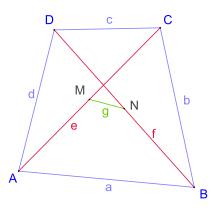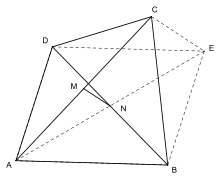Euler's quadrilateral theorem
Euler's quadrilateral theorem or Euler's law on quadrilaterals, named after Leonhard Euler (1707–1783), describes a relation between the sides of a convex quadrilateral and its diagonals. It is a generalisation of the parallelogram law which in turn can be seen as generalisation of the Pythagorean theorem. Because of the latter the restatement of the Pythagorean theorem in terms of quadrilaterals is occasionally called the Euler–Pythagoras theorem.

Theorem and special cases
For a convex quadrilateral with sides , diagonals and , and being the line segment connecting the midpoints of the two diagonals, the following equations holds:
If the quadrilateral is a parallelogram, then the midpoints of the diagonals coincide so that the connecting line segment has length 0. In addition the parallel sides are of equal length, hence Euler's theorem reduces to
which is the parallelogram law.
If the quadrilateral is rectangle, then equation simplifies further since now the two diagonals are of equal length as well:
Dividing by 2 yields the Euler–Pythagoras theorem:
In other words, in the case of a rectangle the relation of the quadrilateral's sides and its diagonals is described by the Pythagorean theorem.[1]
Alternative formulation and extensions

Euler originally derived the theorem above as corollary from slightly different theorem that requires the introduction of an additional point, but provides more structural insight.
For a given convex quadrilateral Euler introduced an additional point such that forms a parallelogram and then the following equality holds:
The distance between the additional point and the point of the quadrilateral not being part of the parallelogram can be thought of measuring how much the quadrilateral deviates from a parallelogram and is correction term that needs to be added to the original equation of the parallelogram law.[2]
being the midpoint of yields . Since is the midpoint of it is also the midpoint of , as and are both diagonals of the parallelogram . This yields and hence . Therefore, it follows from the intercept theorem (and its converse) that and are parallel and , which yields Euler's theorem.[2]
Euler's theorem can be extended to a larger set of quadrilaterals, that includes crossed and nonplaner ones. It holds for so called generalized quadrilaterals, which simply consist of four arbitrary points in connected by edges so that they form a cycle graph.[3]
Notes
- Lokenath Debnath: The Legacy of Leonhard Euler: A Tricentennial Tribute. World Scientific, 2010, ISBN 9781848165267, pp. 105–107
- Deanna Haunsperger, Stephen Kennedy: The Edge of the Universe: Celebrating Ten Years of Math Horizons. MAA, 2006, ISBN 9780883855553, pp. 137–139
- Geoffrey A. Kandall: Euler's Theorem for Generalized Quadrilaterals. The College Mathematics Journal, Vol. 33, No. 5 (Nov., 2002), pp. 403–404 (JSTOR)
References
- Deanna Haunsperger, Stephen Kennedy: The Edge of the Universe: Celebrating Ten Years of Math Horizons. MAA, 2006, ISBN 9780883855553, pp. 137–139
- Lokenath Debnath: The Legacy of Leonhard Euler: A Tricentennial Tribute. World Scientific, 2010, ISBN 9781848165267, pp. 105–107
- C. Edward Sandifer: How Euler Did It. MAA, 2007, ISBN 9780883855638, pp. 33–36
- Geoffrey A. Kandall: Euler's Theorem for Generalized Quadrilaterals. The College Mathematics Journal, Vol. 33, No. 5 (Nov., 2002), pp. 403–404 (JSTOR)
- Dietmar Herrmann: Die antike Mathematik: Eine Geschichte der griechischen Mathematik, ihrer Probleme und Lösungen. Springer, 2013, ISBN 9783642376122, p. 418
External links
| Wikimedia Commons has media related to Euler's theorem for quadrilaterals. |